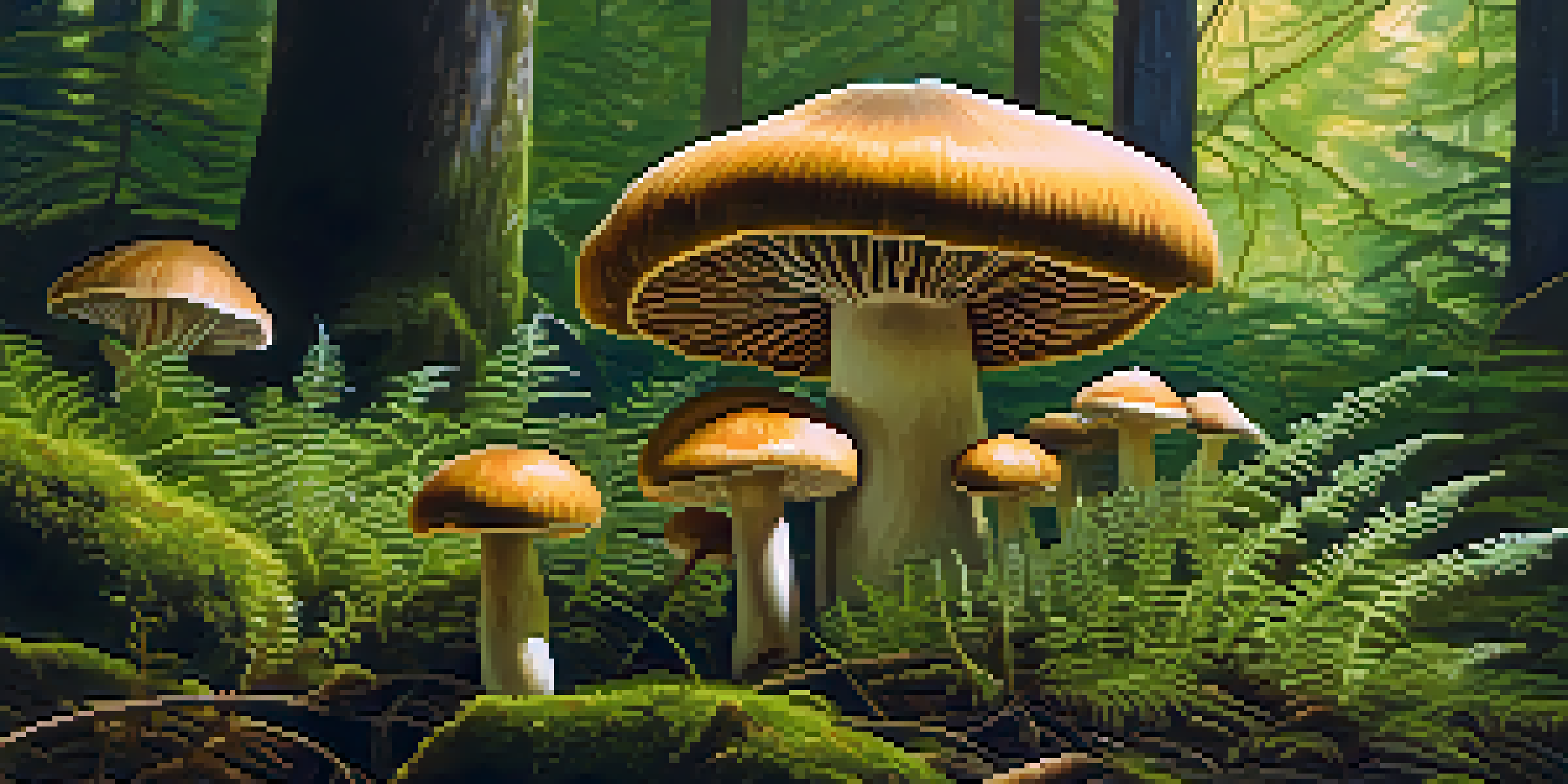The Mechanism of Action of Psilocybin on Brain Activity

What is Psilocybin and Its Sources?
Psilocybin is a naturally occurring psychedelic compound found in certain mushrooms, often referred to as magic mushrooms. These mushrooms have a long history of use in various cultures for spiritual, recreational, and therapeutic purposes. When ingested, psilocybin is converted into psilocin, which is the active form that interacts with our brain's receptors.
Psychedelics can help us to see that we are part of something greater than ourselves.
The primary source of psilocybin is the Psilocybe genus of mushrooms, which includes species like Psilocybe cubensis and Psilocybe semilanceata. These mushrooms are often sought after for their hallucinogenic effects, which can lead to altered perceptions, emotional experiences, and even profound insights. Despite their allure, it's essential to approach their use with caution due to legal and health considerations.
In recent years, interest in psilocybin has surged, particularly in the context of mental health treatment. Research is increasingly exploring its potential to alleviate conditions like depression, anxiety, and PTSD, making it a hot topic in the fields of psychology and neuroscience.
Understanding the Brain's Serotonin System
To grasp how psilocybin works, it's important to understand the role of serotonin, a neurotransmitter crucial for mood regulation, cognition, and overall brain function. Psilocin mimics serotonin and binds to serotonin receptors in the brain, particularly the 5-HT2A receptor. This interaction is believed to be a key factor in the psychedelic effects experienced during a psilocybin trip.

The brain's serotonin system is complex and significantly influences how we perceive reality, process emotions, and connect with others. By activating these receptors, psilocybin can induce changes in perception, thought patterns, and emotional states, leading to experiences that many describe as mystical or transformative. This mechanism also underlies its potential therapeutic benefits.
Psilocybin: A Natural Psychedelic
Psilocybin, found in magic mushrooms, has gained attention for its potential therapeutic benefits in treating mental health conditions.
Interestingly, studies have shown that psychedelics like psilocybin can increase neural connectivity, allowing different regions of the brain to communicate more freely. This increased connectivity can lead to new insights and perspectives, which may be particularly helpful for individuals stuck in negative thought patterns.
The Role of Default Mode Network (DMN) in Psilocybin Effects
The Default Mode Network (DMN) is a network of brain regions that is active when we are at rest and not focused on the external environment. It plays a crucial role in self-referential thought, daydreaming, and introspection. Psilocybin appears to decrease the activity of the DMN, which can lead to a sense of ego dissolution and a loss of the usual boundaries of self.
The mind is like a parachute. It doesn't work if it is not open.
This reduction in DMN activity is thought to be a significant factor in the therapeutic effects of psilocybin. By quieting the inner critic and the narratives that often plague our minds, psilocybin may help individuals confront and process deep-seated issues or traumas. This shift in brain activity can create a feeling of interconnectedness with the world around us.
Moreover, the decreased DMN activity allows for greater access to unconscious thoughts and feelings. Many users report that this can lead to profound insights and a reevaluation of their life circumstances, which can be a catalyst for change and healing.
The Impact of Psilocybin on Brain Connectivity
One of the most fascinating aspects of psilocybin's action is its ability to enhance brain connectivity. Neuroimaging studies have shown that under the influence of psilocybin, different regions of the brain that typically operate independently begin to communicate more freely. This increased connectivity can manifest as a more vivid sensory experience or a shift in perception.
For instance, a person might experience synesthesia, where they 'see' sounds or 'hear' colors. This phenomenon highlights how psilocybin can alter the usual pathways of communication within the brain, leading to a unique and often profound experience. Such changes in connectivity also suggest potential applications in treating mental health disorders.
Impact on Brain Connectivity
Psilocybin enhances communication between different brain regions, leading to altered perceptions and potential breakthroughs in mental health treatment.
Enhanced connectivity may help break rigid thought patterns associated with conditions like depression and anxiety. By fostering new connections, psilocybin may enable individuals to approach their challenges from fresh perspectives, potentially leading to lasting changes in mood and behavior.
Psilocybin and Neuroplasticity: A Path to Healing
Neuroplasticity, the brain's ability to reorganize itself by forming new neural connections, is another critical aspect of psilocybin's effects. Research suggests that psychedelics may promote neuroplasticity, allowing the brain to adapt and change in response to experiences. This is particularly relevant in therapeutic contexts, where healing from trauma or depression is often needed.
Psilocybin may encourage the growth of new neurons and synaptic connections, which can be especially beneficial for mental health. This ability to 'reset' certain brain circuits may help individuals overcome entrenched negative patterns of thinking or behavior. In essence, psilocybin can act as a catalyst for personal growth and transformation.
Many studies are investigating psilocybin's potential as a treatment for various mental health conditions. By harnessing its effects on neuroplasticity, researchers hope to develop treatments that can provide lasting relief for people suffering from conditions that have been resistant to traditional therapies.
Therapeutic Applications of Psilocybin: Current Research
As research into psilocybin continues to grow, so does its potential therapeutic applications. Clinical trials are exploring its efficacy in treating conditions such as depression, anxiety, PTSD, and substance use disorders. The results thus far have been promising, indicating significant improvements in patients' mental health and overall well-being following psilocybin-assisted therapy.
One notable study found that participants experienced substantial reductions in depressive symptoms after just one or two doses of psilocybin, with effects lasting for weeks or even months. This is particularly encouraging given the limitations of traditional antidepressants, which can take weeks to show results and often come with undesirable side effects.
Promoting Neuroplasticity
Research suggests psilocybin may foster neuroplasticity, allowing the brain to form new connections and aiding in recovery from trauma and depression.
Furthermore, psilocybin's ability to induce profound psychological insights during therapy sessions may enhance the effectiveness of therapeutic interventions. By facilitating deep emotional experiences and fostering a sense of connectedness, psilocybin may help patients address underlying issues that contribute to their mental health struggles.
Safety, Risks, and Future Perspectives on Psilocybin
While psilocybin shows great promise, it's essential to consider safety and potential risks. As with any substance, there can be adverse effects, especially in uncontrolled settings. Individuals with a personal or family history of mental health disorders are often cautioned against using psychedelics, as they may trigger or exacerbate underlying conditions.
However, when used in a controlled, therapeutic environment, psilocybin appears to have a favorable safety profile. Many participants in clinical trials report positive experiences, with few serious adverse effects. This highlights the importance of further research and the need for trained professionals to guide the therapeutic process.

Looking ahead, the future of psilocybin research is bright. As societal attitudes shift and more studies validate its therapeutic potential, psilocybin may soon become a valuable tool in mental health treatment. With ongoing research, we can better understand its mechanisms and develop guidelines for its safe and effective use.